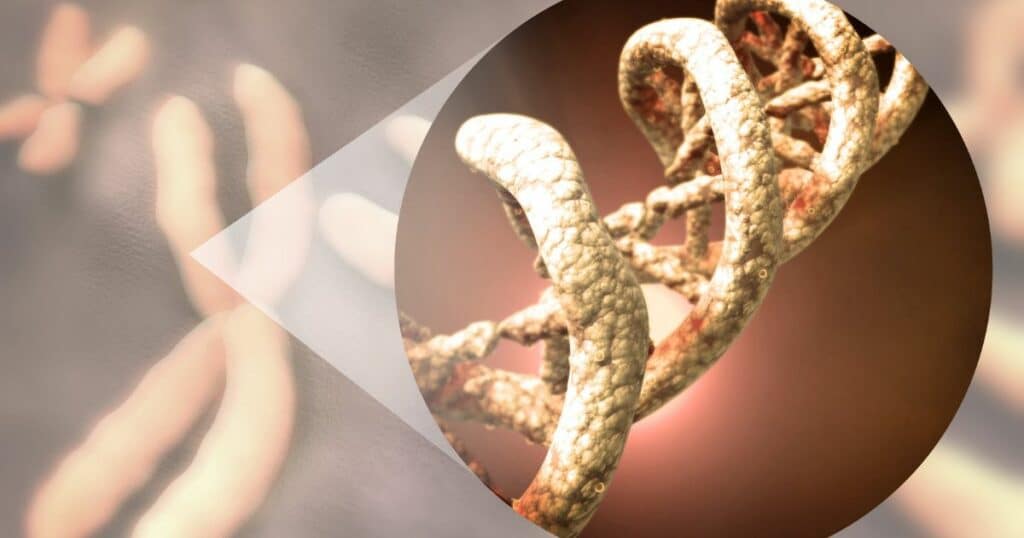Hair genetics play a vital role in determining the characteristics and traits of an individual’s hair, such as texture, color, and thickness. The unique composition of genes inherited from one’s parents is responsible for the specific attributes of different ethnic backgrounds. Thus, understanding the science behind hair genetics can provide insights into the complexities of human hair and how it reflects our ancestry.
Genetic factors in hair are influenced by multiple genes and alleles, working together to create diverse hair textures, such as straight, wavy, or curly hair. For example, two sets of genes are responsible for straight hair in Asian and European populations. Furthermore, the MC1R gene controls the melanocortin 1 receptor, a protein involved in melanin production, and influences hair color. Hair loss is another aspect primarily affected by genetics, although it can also be impacted by other factors such as stress levels, nutrition, and medications.
Key Takeaways
- Genetics greatly influence hair characteristics such as texture, color, thickness, and the potential for hair loss.
- Different genes and alleles determine hair traits in various ethnic backgrounds, accounting for the vast diversity of human hair characteristics.
- While genetic factors are significant, environmental and lifestyle factors may also affect hair properties, including the progression of hair loss.
Understanding Hair Genetics
Dominant and Recessive Genes
Hair genetics is a complex field of study, and multiple genes contribute to the variations in hair characteristics. An individual’s hair traits result from the interaction between dominant and recessive genes present in the DNA. These genes are located on chromosomes and exist in different forms called alleles. Dominant alleles are more likely to be expressed in the phenotype, while recessive alleles only become apparent in the absence of dominant counterparts.
Hair Texture and Color
Various genes determine hair texture and color:
1. Hair Color: The amount of melanin, a pigment, in the hair influences its color. There are two types of melanin: eumelanin and pheomelanin. Eumelanin is responsible for black and brown hair colors, while pheomelanin gives rise to red and blond hair shades. Hair color is inherited through a combination of multiple genes, creating a vast array of possible shades.
2. Hair Texture: Genetic factors play a major role in determining hair texture—be it straight, wavy, or curly—and the thickness of individual strands. Research suggests that different genes influence hair texture and thickness in people of various ethnic backgrounds. For instance, a genome-wide association study might reveal genes associated with a specific hair type in a particular population.
In conclusion, understanding hair genetics involves examining the relationship between dominant and recessive alleles, as well as the contribution of specific genes to hair color and texture. Further research into this complex field will help us unlock molecular secrets and provide insights into inherited hair characteristics.
Genetic Patterns in Hair Growth
Hair Whorl and Direction
Hair whorls, which are spiral patterns formed by hair growing in either a clockwise or counterclockwise direction, are influenced by genetic factors. These distinct patterns can occur on the scalp, and their direction is an inheritable trait. The hair whorl direction may be associated with an individual’s phenotype and could potentially be connected to abnormal neurological development, although more research on this topic needs to be conducted.
Hair Curliness
Another aspect of hair genetics is hair curliness, which is determined by several factors, including inheritance. Curly hair manifests in various forms and can range from loose waves to tight coils. Genetic variations can contribute to the different degrees of hair curliness, and these differences between individuals are a result of multiple genes working in combination.
Some factors that influence the curliness of hair include:
- The shape of the hair follicle: Round follicles typically produce straight hair, while oval-shaped follicles result in curly hair.
- The distribution of keratin proteins and chemical bonds within the hair shaft: Imbalances in these components can lead to hair curling.
In summary, both hair whorl direction and hair curliness are influenced by genetic factors, with inheritance playing a significant role in determining these unique characteristics. Additional research on the connection between hair patterns and other aspects of human development may provide further insight into the complexity of hair genetics.
Genetic Influence on Hair Loss
Male Pattern Baldness
Male Pattern Baldness (MPB), also known as androgenetic alopecia, is a common type of hereditary hair loss that affects men. It is primarily influenced by genetics. Studies have shown that the X chromosome plays a significant role in MPB, with the androgen receptor (AR) gene being a key factor in determining hair loss patterns. Men with a family history of MPB are more likely to experience a receding hairline and thinning hair on the crown of their head.
Other factors that can contribute to hair loss in men include hormonal imbalances, such as increased sensitivity to dihydrotestosterone (DHT), which is derived from the male hormone testosterone. This sensitivity can cause the hair follicles to shrink, resulting in thinner, shorter, and eventually, no hair growth. Additionally, lifestyle factors like stress, poor nutrition, and certain medications can exacerbate hair loss.
Female Pattern Baldness
Female Pattern Baldness, a related form of androgenetic alopecia, is a hereditary hair loss condition that affects women. While it shares some genetic factors with MPB, the patterns of hair loss in women are different. Rather than a receding hairline, women with this condition typically experience diffuse thinning throughout the scalp, and the hair parting becomes gradually wider.
The role of genetics in female pattern hair loss is complex. Research is still ongoing to identify the specific genes and hormonal factors involved. Some studies suggest that hormonal imbalances, particularly those involving androgens, can also play a role in hair loss in women. Like men, women can experience hair loss due to factors such as stress, poor nutrition, and certain medications.
In conclusion, genetics play a significant role in hair loss for both men and women. While hereditary factors may predispose an individual to baldness, other variables such as hormones, stress, and nutrition can impact the severity and progression of hair loss. Understanding the complex interplay of genetics and other factors is essential for identifying effective treatments and interventions for those affected by hair loss.
Other Genetic Conditions Affecting Hair
Alopecia Areata
Alopecia areata is an autoimmune disorder that causes hair loss in small, round patches on the scalp. It occurs when the immune system mistakenly attacks hair follicles, leading to hair loss. Although the exact cause of this condition is unknown, genetics are believed to play a role. Alopecia areata can begin at any age but is most common in children and young adults. While treatment options are available, there is currently no cure for the condition.
Trichotillomania
Trichotillomania is a psychological condition characterized by the compulsive urge to pull out one’s hair, often resulting in noticeable hair loss. This disorder has been linked to genetic factors, as well as environmental and stress-related triggers. Cognitive behavioral therapy is often used for treatment, helping individuals recognize and manage their hair-pulling habits.
Cicatricial Alopecia
Cicatricial alopecia, also known as scarring alopecia, is a group of rare hair loss disorders characterized by the destruction of hair follicles and subsequent scarring. The exact cause of cicatricial alopecia is unknown, but it may be related to genetic factors, infections, or inflammation. Treatment options include medications to reduce inflammation and halt hair loss progression, but hair regrowth is often not possible due to irreversible scarring.
Traction Alopecia
Traction alopecia is a form of hair loss caused by chronic tension or pulling on the hair, often due to specific hairstyles, such as tight ponytails or braids. While not a genetic condition, traction alopecia can be influenced by hair type and texture, making some individuals more susceptible to the condition. Prevention is crucial, by avoiding tight hairstyles and tension on the hair follicles.
Environmental and Lifestyle Impact on Hair Genetics
A variety of environmental and lifestyle factors can impact hair genetics beyond our inherited predispositions. These factors may affect hair growth, texture, color, and lead to hair loss.
Stress has a significant influence on our hair, as it can cause hormonal imbalances and disrupt the natural hair growth cycle. High stress levels may result in temporary or long-term hair loss, or thinning of the hair.
Nutrition plays a critical role in maintaining healthy hair. A well-balanced diet provides essential vitamins and minerals that support hair growth and overall health. Nutrient deficiencies, such as a lack of protein, iron, or vitamins, can lead to hair loss or weakened hair structure.
Certain medications and drugs may also impact the growth and appearance of hair. Some medications, like chemotherapy drugs, can cause hair loss as an unfortunate side effect. Other drugs might affect hormonal balance or interfere with the hair growth cycle.
Radiation therapy can potentially cause hair loss, as it affects rapidly dividing cells, including those that produce hair. Depending on the treated area, hair loss can be temporary or permanent.
Physical appearance, including hair texture and thickness, can be influenced by a combination of genetic and environmental factors. Hair texture differences between ethnic backgrounds have been linked to genetic variations in specific genes like EDAR and FGFR2.
As individuals age, hair follicles decrease in size and produce less pigment, leading to a gradual greying of hair. This natural process can be hastened by environmental or lifestyle factors, such as excessive sun exposure or nutritional deficiencies.
Hormonal changes may cause temporary or permanent changes in hair. For example, pregnancy may lead to thicker, more lustrous hair in some women, due to increased hormone levels. However, hair loss may occur a few months after giving birth as hormonal levels normalize.
Similarly, the hormonal shifts during menopause can contribute to changes in hair quality and loss. Reduction in estrogen and progesterone production may weaken hair growth and result in thinning or hair loss, particularly in certain areas of the scalp.
In conclusion, various environmental and lifestyle factors can impact our hair genetics, including stress, nutrition, medications, drugs, radiation therapy, physical appearance, age, hormones, hormonal changes, pregnancy, and menopause. Considering these factors, adopting a healthy lifestyle may help support healthy hair growth and appearance throughout our lives.
Groundbreaking Studies in Hair Genetics
Taizhou Longitudinal Study Cohort
In recent years, significant advances have been made in understanding hair genetics through large-scale studies, such as the Taizhou Longitudinal Study Cohort. This study leverages the power of genome-wide association studies (GWAS) to identify genetic polymorphisms that influence various traits, including hair characteristics. By examining the genetic makeup and various phenotypic traits within this extensive cohort, researchers have been able to gain valuable insights into the complex genetics behind hair growth and related functions.
These findings have also shed light on how certain genetic variations may impact neurological development, as well as behavioral and cognitive traits. The exploration of these associations has generated a wealth of knowledge and provided opportunities for further research in understanding how hair genetics intersect with other aspects of human biology.
National Survey of Physical Traits Cohort
Similarly, the National Survey of Physical Traits Cohort has made notable contributions to the field of hair genetics. This study primarily focuses on the genetic factors underlying human pigmentation, such as hair color. By examining the genomes and physical traits of thousands of individuals, researchers participating in this cohort have been able to identify numerous genetic variants and loci associated with hair color and other pigmentation traits.
Among the significant discoveries made through this study is the identification of multiple polymorphisms that contribute to the diverse range of hair colors seen in the human population. Furthermore, this research has advanced our understanding of the genetic mechanisms that control the production of melanin, the molecule responsible for hair and skin color.
To sum up, groundbreaking studies like the Taizhou Longitudinal Study Cohort and the National Survey of Physical Traits Cohort have greatly expanded our knowledge of hair genetics. By leveraging advanced genetic analysis techniques, these studies have provided insights into the complex genetic underpinnings of hair growth, coloration, and their associations with other human traits. These findings pave the way for future research and potential applications in personalized medicine and the study of human biology.
Frequently Asked Questions
What determines hair color and texture?
Genetic factors mainly determine hair color and texture. Genes influence the production of pigments that give hair its color, such as melanin. The texture of hair—whether it’s straight, wavy, or curly—depends on the shape of the hair shaft, which is also influenced by genetics. Hair might be lighter, dry, or frizzy due to genetic conditions such as Uncombable Hair Syndrome.
What genes are responsible for hair loss?
Hair loss is a complex trait that involves multiple genes and environmental factors. There is no single gene responsible for hair loss. However, some research has identified specific genes that are associated with an increased risk of developing hair loss, such as the androgen receptor (AR) gene.
How is hair thickness inherited?
Hair thickness, also referred to as hair density, is influenced by genetics. Studies suggest that different genes determine hair thickness in people of different ethnic backgrounds. Two known genes that play a role in hair thickness are EDAR and FGFR2. The way these genes interact with each other and with environmental factors helps determine the overall thickness of an individual’s hair.
Can genetic testing predict hair-related traits?
Genetic testing can provide some insights into hair-related traits, such as color and the risk of hair loss. However, predicting hair traits accurately is challenging due to the complex interactions between multiple genes and environmental factors. As a result, genetic testing can only offer a partial picture of an individual’s hair attributes.
Is frizzy hair determined by genetics?
Frizzy hair can be determined by genetics. For example, Uncombable Hair Syndrome is a genetic condition that causes hair to grow in multiple directions, making it difficult to flatten down with a comb, resulting in frizzy hair. However, other factors, such as environmental conditions and haircare routines, can also contribute to frizzy hair.
How do multiple genes influence hair inheritance?
Hair inheritance, like many traits, is influenced by multiple genes working together. These genes interact with each other as well as environmental factors to produce the final hair characteristics. This complex interplay between genes and the environment means that it’s difficult to predict the exact outcome of an individual’s hair traits, as a combination of factors determines them.






